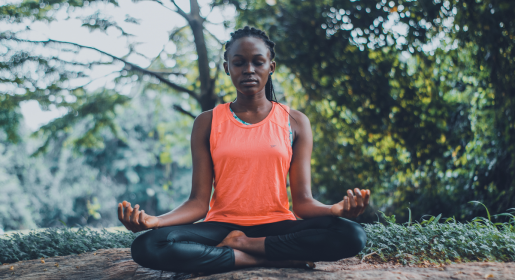Practicing mindfulness anytime, anywhere
The constant stress of our day-to-day lives can make it difficult to focus on internal emotions. Many Americans have turned to mindfulness techniques, such as meditation and yoga, to help reduce anxiety and improve overall emotional well-being.
But what is mindfulness? And how can it be practiced?
“Mindfulness is the practice of intentionally bringing yourself to the present moment in a non-judgmental way,” said Lindsey Knott, Ph.D., a licensed psychologist at Baylor College of Medicine.
To practice, focus on your thoughts or experiences, such as pain or sensory experiences, without judging yourself for having those feelings. Being mindful and noticing what is occurring in the present allows you to reconsider values and goals.
Mindfulness is not a permanent state of mind, as your thoughts, emotions and pain come in waves.
“We tend to avoid unwanted experiences. These are experiences that all humans will have, so the more we can allow ourselves to be aware of their presence, the clearer we will be when we move toward things that are meaningful, difficult or stressful.”
What are the benefits?
Mindfulness facilitates stress reduction and assists with symptoms of depression, anxiety and trauma. For those focusing on mental health, it’s a newer intervention compared to traditional cognitive behavioral therapy approaches.
It is a different way of considering how people orient their thoughts. Instead of ignoring your emotions, mindfulness asks you to stay with them.
“We are all multitaskers with multiple projects occurring at once. We rarely stop to consider how working at this level of efficiency may impair our performance or enhance stress.”
Mindfulness techniques
Mindfulness can be practiced in a meditative state or informally:
- Meditative approach: During the meditative practice, you are seated in silence or listening to a guided meditation with your eyes closed, while your body is in an alert, purposeful stance. Mindfulness uses the meditative stance to guide people to move toward their experiences.
- Informal approach: Finding a quiet area to meditate can be challenging. The informal, take-it-with-you approach allows you to practice mindfulness anywhere. Mindful techniques bring you back to the present moment while in the middle of a conversation, working or seated on a crowded bus. Harness aspects of mindfulness by shifting your focus on your breaths or focusing on what you are doing in that moment.
Make sure to take a non-judgmental stance while practicing mindfulness, as it allows you to be more open to your experiences. It can help cultivate self-compassion, understanding, and increase flexibility.
“Allowing newness to come in and approaching our experience with curiosity can lead us to new learning, new behavior and freedom.”
Dr. Knott is an assistant professor in the Menninger Department of Psychiatry and Behavioral Sciences at Baylor. See services at the Baylor Psychiatry Clinic or call (713) 798-4857.
Additional Resources
What does it mean to practice mindfulness?
Seven tips to help reduce the effects of stress
-By Homa Shalchi




